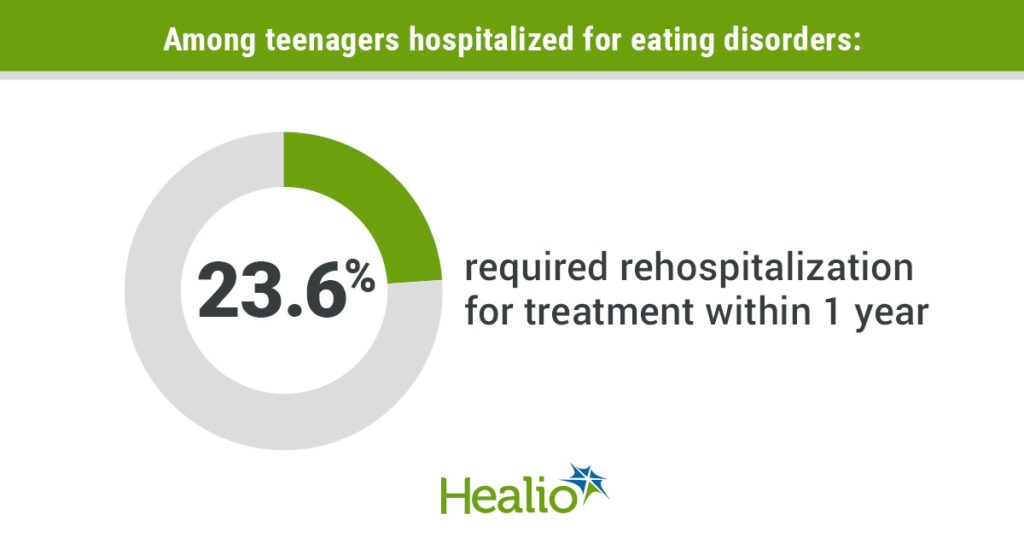January 31, 2024
2 min read
Add topic to email alerts
Receive an email when new articles are posted on
Please provide your email address to receive an email when new articles are posted on .
“
data-action=”subscribe”>
Subscribe
We were unable to process your request. Please try again later. If you continue to have this issue please contact customerservice@slackinc.com.
Back to Healio
Key takeaways:
Hospitalizations related to eating disorders are increasing among adolescents in the United States.
Anorexia nervosa was the most common eating disorder, occurring in over half of adolescents.
Hospitalizations for eating disorders have increased steadily among adolescents in the United States, including a spike during the COVID-19 pandemic, researchers reported in Hospital Pediatrics.
According to one of the researchers, the new study was inspired by the results of a 2022 study that showed an increase in eating disorder admissions during the pandemic.

Data derived from Rappaport DI, et al. Hosp Pediatr. 2024;doi:10.1542/hpeds.2023-007381.

Megen Vo
“Clinically, my colleagues and I have felt that there has been an increase in the number of patients needing inpatient stabilization for eating disorders, and we wanted to see if that was reflective in the actual data,” Megen Vo, MD, medical director of the Eating Disorders Outpatient Clinic at Stanford Medicine Children’s Health, told Healio. “We wanted to look at a longer time period and with a larger sample to see what the trends were among adolescents needing hospital admission for eating disorders.”
Vo and colleagues studied data from the PedsNET network of children’s hospitals across the country to see how many patients were admitted for disordered eating, binge eating disorders, anorexia nervosa, bulimia nervosa, avoidant-restrictive food intake disorder (ARFID), or other eating disorders.
The researchers included 13,403 hospitalizations by 8,652 patients in their analysis. The mean age of the patients was 15.8 years, and they had a median BMI percentage of 90.3%.
Hospitalizations increased more than sevenfold from 294 in 2010 to 2,135 in 2021, which was the highest yearly total. Hospitalizations increased more than 70% from 2019 — the year before the pandemic — to 2021. They decreased slightly after that to 1,783 cases in 2022.
Nearly one-quarter of the cohort (23.6%) required rehospitalization for eating disorder treatment within 1 year.
“We weren’t surprised to see that the numbers of patients needing to be admitted have steadily increased since 2010, with an alarming spike in admissions during the COVID-19 pandemic,” Vo said.
Anorexia nervosa was the most common eating disorders, representing 57.5% of cases. Around half of patients were classified as not malnourished. The other half were classified as mildly (25%), moderately (18.6%) or severely (5.4%) malnourished.
Many patients received a diagnosis of depression (58.5%) or anxiety (57%) and 21.9% reported suicidal thoughts.
Vo and colleagues were surprised to learn that, on average, patients who were admitted for being medically unstable were of a “normal” weight.
“Despite being objectively malnourished, if you plotted them on the growth curve, they would not look underweight, but their bodies are starving from lack of nutrition and shutting down their vital signs and other vital functions,” Vo said.
The results, Vo said, highlight that patients with eating disorders do not necessarily fit the stereotypes of those who look emaciated. She is interested in identifying which patients are at highest risk for being readmitted.
“People can suffer from eating disorders and be so malnourished they need to be in the hospital and still look average on the growth curve,” Vo said. “I would also hope that other pediatricians and providers will take from this that the numbers of patients needing care for an eating disorder has gone up over time. Eating disorders are important health issues that are common and should be screened for and asked about.”
References:
Hartman-Munick SM, et al. JAMA Pediatr. 2023;doi:10.1001/jamapediatrics.2022.4346.
Rappaport DI, et al. Hosp Pediatr. 2024;doi:10.1542/hpeds.2023-007381.
Published by:
Add topic to email alerts
Receive an email when new articles are posted on
Please provide your email address to receive an email when new articles are posted on .
“
data-action=”subscribe”>
Subscribe
We were unable to process your request. Please try again later. If you continue to have this issue please contact customerservice@slackinc.com.
Back to Healio

